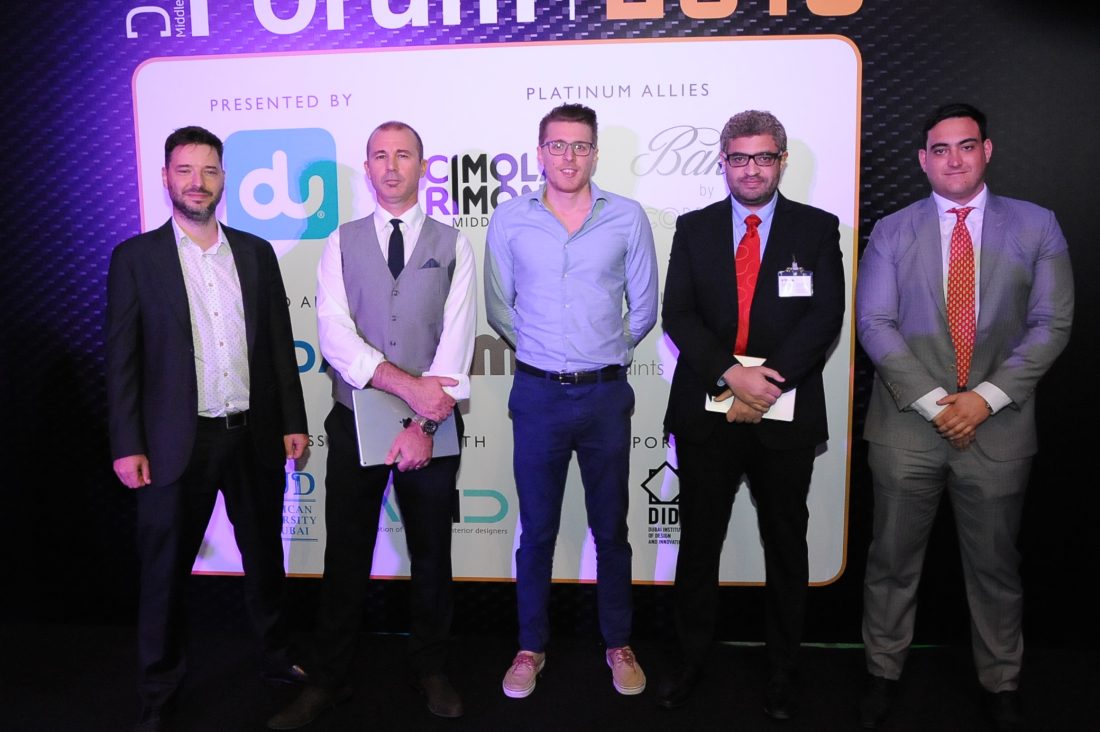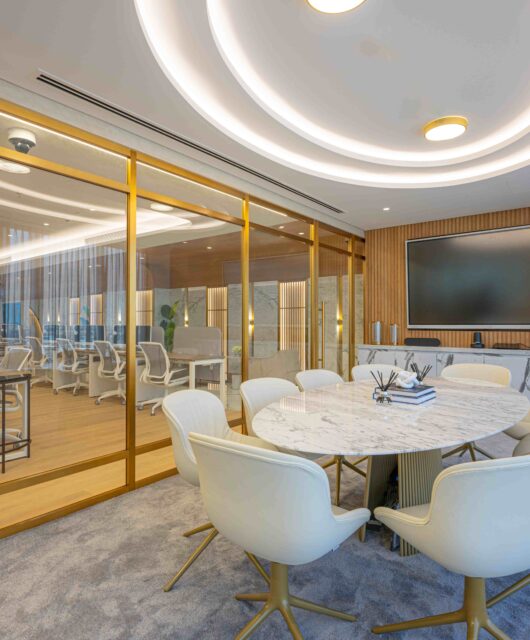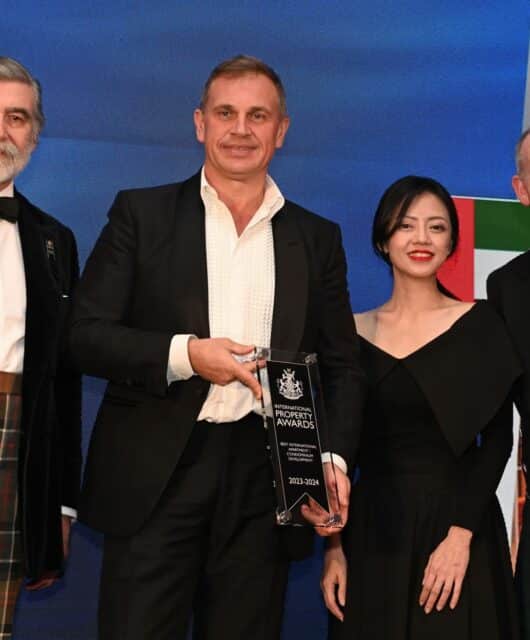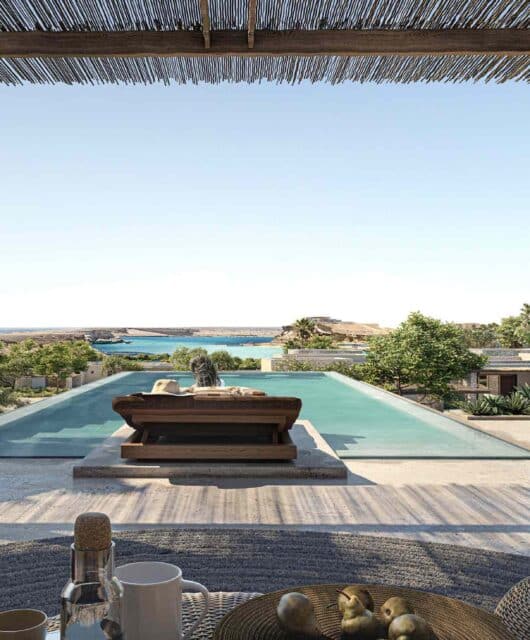An impressive turnout, endless conversations, in-depth design discussions, and networking at par, the first Design Forum 2018 weaved a success story he mission was accomplished when the first Design Forum opened its door to a full house of audience on March 17, 2018, at W Hotel Al Habtoor City. Clearly, success is sweetest and being the first design event by Design Middle East magazine, the response was overwhelming as close to 200 people attended the forum. The industry experts came together and discussed important matters of design and architecture—biophilia, 3D technology, design education, and fit-out trends. There were ample design conversations and creative minds under one roof. Presenting some noteworthy glimpses and highlights from Design Forum 2018:
Welcome note
The event kick-started with a welcome address by Abdelrahim Abusedira, senior executive from DU. Abusedira focussed on how design and architecture provide an identity for what would otherwise be mere structures and shapes. He added: “We are here in Dubai, where design has brought to life countless architectural wonders. such as the Burj Al Arab, the Cayan Tower, Atlantis, and – of course – the iconic Burj Khalifa, just to name a few. Abusedira also emphasised on how technology and design are coming together for the rise of smart cities, “At du, as an enabler and key strategic partner of smart Dubai, we look eagerly forward to the continued unification of technology and design, and we are excited to play a meaningful role in Dubai’s digital transformation into the smartest city in the world.”

Keynote speech
The keynote speaker for Design Forum 2018 was Paul Bishop, owner and founder of Bishop Design. The company is behind some of the UAE’s most recognisable projects such as French bistro and fine dining restaurant La Serre, global restaurant and lounge concepts brought to the region KOI, Katana Robata & Sushi, BOA Steakhouse and more recently Beat of Angels lounge and club. At the event, Bishop discussed “the art of creating ‘design experiences’ across all sectors and the power of social media.”

Panel discussion: Biophilia in design
The benefits of nature are abundant and that’s what the design industry is shifting its focus to. Biophilic design is all about creating good habitat for people as a biological organism in the modern buildings and constructions that can enhance people’s health, fitness deficiencies of contemporary buildings.
The panel which was moderated by Dr Bhakti More, associate professor, Manipal Academy of Higher Education, Dubai campus included Boris Fabinski, principal landscape architect, SSH; Hania Arafat, workplace consultant, Steelcase; Maja Kozel, spatial designer and founder of Maja Kozel Design; Oliver Baxter, insight programme manager MEA, Herman Miller, and Shalini Bhatnagar, CEO, Fiona Environs.

Baxter credits biophilia in having a positive impact on productivity, “Biophilic design impacts the workplace environment greatly, and bumps up worker productivity. Turn it into a game, give employees the responsibility to handle a plant at work, reward them for the best plant at the end of the month, and see the positive results.” Arafat also pointed out that how people neglect good designs, “The biggest challenge is to make our clients understand this concept, it’s not a matter of cost, it’s all about discussing simple decisionmaking factors which can be easily implemented.”\
Kozel shared various examples of biophilic-inspired designs and said, “ Biophilia should be the essence of design.” Fabinski discussed how more and more clients are demanding for biophilic elements in their projects, “The trend of biophilic designs has heavily picked up and clients are asking about it. We are doing the refurbishment of the mall in Bahrain where greenery is one of the key elements in the design to create more livable spaces.” The discussion took an interesting turn when the element of sustainability was talked about, and Bhatnagar suggested, “Biophilic design shouldn’t be linked with just sustainability; it should become a compulsory part of all designs. It’s not only about the plants, it’s about the colours, shapes, textures, and more.
Panel discussion: Changing face of design education
The second panel at the Design Forum highlighted the changing face of design education. It’s interesting to see how the education institutions are focusing on the relevance of design and it’s a reason to enhance the environment and hence the world we live in.
The panel was moderated by Dr Dolly Daou, director, APID and other panellists included Sasan Niknam, design manager, U+A Architect; Kristin Lee, chair and associate professor of interior design of AUD; Salim Hussain, principal architect, Atkins; and Hani Asfour, associate dean, DIDI.

Some of the most relevant aspects of design education were highlighted, one of which is the demand for infrastructure. Asfour shared, “If we want to become the leaders in design, we need freedom in the pillars of infrastructure, mindset, and talent. We teach our students to humanise technology, to understand it so as to make the best possible use of it.” Lee further discussed at length the importance of bright talent and not just design solvers. She added, “It’s important to create not just design solvers, but design thinkers.” Niknam empahasised on how budding talent should express their talent freely without any hesitation, “Young talent coming out of design schools need to be familiar with how the industry works, but should also be allowed to express themselves in the professional environment.”
Hussain urged to have more exchange programs and internships, “Internships are beneficial to both parties (design students & professionals). The industry needs to be more involved with the young talent and the academia needs to ensure the relevant subjects are being taught. It’s all about the balance.”
Presentation: Fit-out trends
The presentation at the forum focussed on the fit-out industry in the region and what makes it one of the booming markets in the design industry? Exploring the current market situation, innumerable challenges, competition, trends, rules, and regulations. Tom Gilmartin, business development manager from ALEC FITOUT anchored this interesting section at the event. Gilmartin discussed the fit-out industry and its trends at length in the UAE especially the growing Dubai market.

He also discussed the challenges, trends, and exciting projects in the region. He added, “The fit-out market in the region is growing but there are few challenges like payments, design issues which need to be taken care of at the soonest. “Current trends in the fit-out industry include value engineering, fast track, design-build, and complete fit-out solutions.” Gilmartin also shared his views on how Expo 2020 is bringing great opportunities in this region; “Expo 2020 has brought about plenty of opportunities for the fit-out industry in the UAE, with fi-tout contract business valued at nearly AED3bn.”
Panel discussion: 3D technology in design & architecture
The last panel discussion was about the latest innovative trend – 3D technology is benefitting the design and architecture field.
The panel which was moderated by Benjamin Piper, principal and partner, Killa Design, included Dominic Wright, business development director, Generation 3D; Scott Peter Stanley Jezzard, head of design, PNC Architects; Hany Salah, area business manager, Trimble Solutions; and Alexander Papantoniou, managing director, D2M Solutions.

Jezzard highlighted how technology brings newness to a project, “Technology brings a whole new logic to the construction process– we need to build something new, not just repeat the same old. Also, with performance and efficiency, we’ll also have to keep up with maintaining our ecology.” Awareness of technology is important and Papantoniou shared some valid examples as well at the forum. He said: “No one was designing structures or components for additive manufacturing, and traditional methods were preferred. Engineers need to be educated on the benefits of the 3d printing.” For this technology to reach its peak, architects all over the world must back it up. Wright discussed: “Designing and manufacturing need to go hand-in-hand for 3D printing to be successful. It needs a push from the architects to truly succeed.” It will take some time for people and market to fully accept this technology. Salah felt: “Manpower in MENA is cheap, and that debilitates the strength of 3D printing; why would someone invest in technology when they could just hire someone to construct from scratch? It’ll take some time for this technology to take shape.”
Watch the highlights from design Forum 2018:







